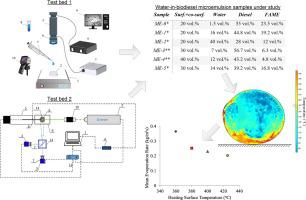当前位置:
X-MOL 学术
›
Exp. Therm. Fluid Sci.
›
论文详情
Our official English website, www.x-mol.net, welcomes your feedback! (Note: you will need to create a separate account there.)
Convective heat transfer in droplets of fuel microemulsions during conductive heating
Experimental Thermal and Fluid Science ( IF 3.2 ) Pub Date : 2021-01-01 , DOI: 10.1016/j.expthermflusci.2020.110258 Nikita Khomutov , Sergey Misyura , Maxim Piskunov , Alexandra Semyonova , Pavel Strizhak , Roman Volkov
Experimental Thermal and Fluid Science ( IF 3.2 ) Pub Date : 2021-01-01 , DOI: 10.1016/j.expthermflusci.2020.110258 Nikita Khomutov , Sergey Misyura , Maxim Piskunov , Alexandra Semyonova , Pavel Strizhak , Roman Volkov

|
Abstract The experimental findings of the convective heat transfer in drops and films of fuel microemulsions heated on hot surfaces are presented. The study examines the Rayleigh-Benard-Marangoni convection in the films of fuel microemulsions heated from below under the conditions close to saturation and the forced convection in the drops of the same liquids in the Leidenfrost state. Laser-induced phosphorescence method is used to record the temperature of drops. Features and characteristics of vaporization and coalescence of the dispersed phase of microemulsions are analyzed by optical microscopy. The experiments are performed with the heated substrates made of sapphire and stainless steel. The fuel microemulsions are manufactured from diesel fuel, fatty acids methyl esters of rapeseed and sunflower oils, distilled water, surfactant – polyethylene glycol ether of isononylphenol, and co-surfactant – 2-ethylhexanol. The results show that the evaporation rate of the dispersed phase of microemulsions largely depends on the total concentration of emulsifier and distilled water. At surface temperatures below 80 °C, the mean diameter of droplets of the dispersed phase decreases linearly with increasing temperature; when the temperature is above 80 °C, the droplets are enlarged about two times, initiating the bubble boiling. The number of the large coalesced droplets of the dispersed phase decreases linearly with time; the process occurs more intensively at surface temperatures above 80 °C. At a local liquid temperature of about 120–150 °C, an intensely heated microemulsion drop partially disintegrates (puffing). With an increase in the surface temperature of the substrate from 360 °C to 425 °C, the evaporation rate of microemulsion drops practically does not change, i.e., it reaches certain asymptotic values. The significant heterogeneity of temperature fields of microemulsion drops in the Leidenfrost state is shown.
中文翻译:

传导加热过程中燃料微乳液液滴中的对流传热
摘要 介绍了在热表面加热的燃料微乳液液滴和薄膜中对流换热的实验结果。该研究检查了在接近饱和的条件下从下方加热的燃料微乳液膜中的 Rayleigh-Benard-Marangoni 对流以及处于 Leidenfrost 状态的相同液体液滴中的强制对流。激光诱导磷光法用于记录液滴的温度。通过光学显微镜分析微乳液分散相的汽化和聚结的特征和特性。实验是在由蓝宝石和不锈钢制成的加热基板上进行的。燃料微乳液由柴油、菜籽油和葵花籽油的脂肪酸甲酯、蒸馏水、表面活性剂 - 异壬基酚的聚乙二醇醚,和辅助表面活性剂 - 2-乙基己醇。结果表明,微乳液分散相的蒸发速率很大程度上取决于乳化剂和蒸馏水的总浓度。在表面温度低于 80 °C 时,分散相液滴的平均直径随温度升高而线性减小;当温度高于 80°C 时,液滴会扩大约 2 倍,开始气泡沸腾。分散相的大聚结液滴的数量随时间线性减少;当表面温度高于 80 °C 时,该过程会更加频繁地发生。在约 120–150 °C 的局部液体温度下,强烈加热的微乳液滴会部分崩解(膨化)。随着基材表面温度从360℃升高到425℃,微乳液的蒸发速率几乎没有变化,即达到一定的渐进值。显示了 Leidenfrost 状态下微乳液滴温度场的显着异质性。
更新日期:2021-01-01
中文翻译:

传导加热过程中燃料微乳液液滴中的对流传热
摘要 介绍了在热表面加热的燃料微乳液液滴和薄膜中对流换热的实验结果。该研究检查了在接近饱和的条件下从下方加热的燃料微乳液膜中的 Rayleigh-Benard-Marangoni 对流以及处于 Leidenfrost 状态的相同液体液滴中的强制对流。激光诱导磷光法用于记录液滴的温度。通过光学显微镜分析微乳液分散相的汽化和聚结的特征和特性。实验是在由蓝宝石和不锈钢制成的加热基板上进行的。燃料微乳液由柴油、菜籽油和葵花籽油的脂肪酸甲酯、蒸馏水、表面活性剂 - 异壬基酚的聚乙二醇醚,和辅助表面活性剂 - 2-乙基己醇。结果表明,微乳液分散相的蒸发速率很大程度上取决于乳化剂和蒸馏水的总浓度。在表面温度低于 80 °C 时,分散相液滴的平均直径随温度升高而线性减小;当温度高于 80°C 时,液滴会扩大约 2 倍,开始气泡沸腾。分散相的大聚结液滴的数量随时间线性减少;当表面温度高于 80 °C 时,该过程会更加频繁地发生。在约 120–150 °C 的局部液体温度下,强烈加热的微乳液滴会部分崩解(膨化)。随着基材表面温度从360℃升高到425℃,微乳液的蒸发速率几乎没有变化,即达到一定的渐进值。显示了 Leidenfrost 状态下微乳液滴温度场的显着异质性。



























 京公网安备 11010802027423号
京公网安备 11010802027423号